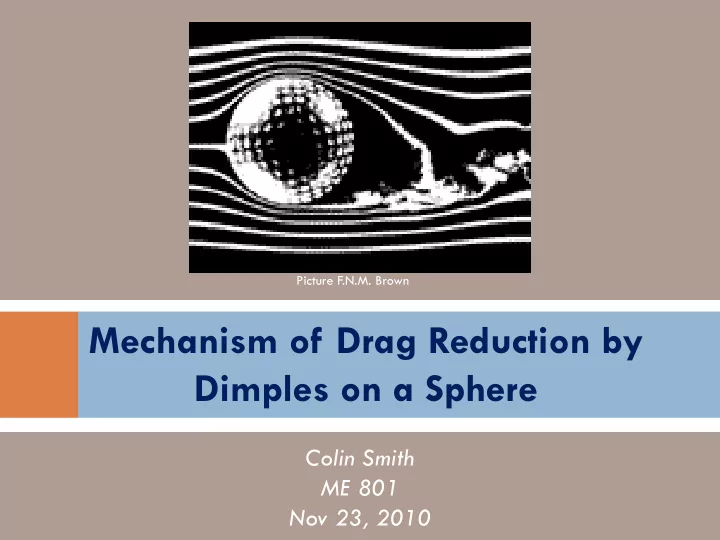

Picture F.N.M. Brown Mechanism of Drag Reduction by Dimples on a Sphere Colin Smith ME 801 Nov 23, 2010
The Big Ideas Previous experiments have found: Dimpled spheres to have up to 50% reduction of drag of smooth spheres The drag on a ball to become constant above certain Reynolds' Numbers (Ball Speeds) 10/18/2011 Colin Smith Slide 2 of 20
Basics of Drag Skin Friction: Form Drag: Viscous shear Pressure difference stresses on surface on the object of the object P F F P F 10/18/2011 Colin Smith Slide 3 of 20
Pressure Coefficient over a Sphere Potential flow solution predicts no drag due to pressure [ D’Alembert’s Paradox] (dotted line) When viscosity is accounted for, separation occurs and the flow is no longer symmetric (solid line) http://qm-aerospace.blogspot.com/2007/03/why-do-golf-balls-have-dimples.html 10/18/2011 Colin Smith Slide 4 of 20
Boundary Layer Separation Separation occurs when the pressure gradient overcomes the momentum 10/18/2011 Colin Smith Slide 5 of 20
Laminar vs Turbulent Boundary Layers 10/18/2011 Colin Smith Slide 6 of 20
Motivation http://www.sciencebuddies.org/science-fair-projects/project_ideas/Sports_p012.shtml Dimples induce a turbulent boundary layer, which has higher momentum and thus delays separation At Re>10 4 , the majority of drag on a sphere is due to pressure difference, not skin friction 10/18/2011 Colin Smith Slide 7 of 20
Findings Dimples reduce drag on a sphere as much as 50% when compared to a smooth surface The drag coefficient remains constant over a range of Reynolds numbers Turbulent boundary layer is caused by separation bubbles in dimples 10/18/2011 Colin Smith Slide 8 of 20
Definitions Reynolds Number Drag Coefficient D= Drag Force d= sphere diameter A=Cross Sectional Area U o = Free Stream Velocity ρ = Density ν= kinematic viscosity U o = Free Stream Velocity 10/18/2011 Colin Smith Slide 9 of 20
Experimental Setup Free stream velocities varied from 5-28 m/s Tiger Woods ball speed Reynolds numbers 0.5x10 5 - 185mph=83m/s 2.8x10 5 Maintains laminar boundary layer over smooth sphere (Jeon S, Choi J, Jeon WP , Choi H, Park J) (Choi J, Jeon WP , Choia H) 10/18/2011 Colin Smith Slide 10 of 20
Flow Over a Smooth Cylinder The separation angle over a smooth golf ball sized sphere was measured at 82 o for 0.5x10 5 ≤ Re ≤2.8x10 5 10/18/2011 Colin Smith Slide 11 of 20
Visualization of Flow Separation (Choi J, Jeon WP , Choia H) Separation is delayed to ϕ =110 o Separation angle constant for Re≥ 0.9x10 5 The trailing edge of the tested sphere is smooth to better show separation 10/18/2011 Colin Smith Slide 12 of 20
Measured Drag Coefficient (Choi J, Jeon WP , Choia H) Drag Coefficient constant for Re≥ 0.9x10 5 10/18/2011 Colin Smith Slide 13 of 20
Effect of Dimples (Choi J, Jeon WP , Choia H) 10/18/2011 Colin Smith Slide 14 of 20
Smoke Wire Test (Choi J, Jeon WP , Choia H) Shows no vortices are ejected 10/18/2011 Colin Smith Slide 15 of 20
Velocity Profile at Re=1.0x10 5 (Choi J, Jeon WP , Choia H) 10/18/2011 Colin Smith Slide 16 of 20
Re=1.5x10 5
Velocity Profiles at Increasing Re Re= 1.0x10 5 First Separation at Dimple III (80 O ) Re= 1.5x10 5 First Separation at Dimple II (71 O ) Re= 2.0x10 5 First Separation at Dimple I (63 O ) (Choi J, Jeon WP , Choia H) If Re> 0.9x10 5 flow always separates from the surface after dimple V 10/18/2011 Colin Smith Slide 18 of 20
Conclusion ( Choi J, Jeon WP , Choia H) 10/18/2011 Colin Smith Slide 19 of 20
References Choi J, Jeon WP , Choia H. “Mechanism of Drag Reduction by Dimples on a Sphere.” Physics of Fluids. Vol.18 4 041702. 2006 Jeon S, Choi J, Jeon WP , Choi H, Park J, “Active control of flow over a sphere at a sub- critical Reynolds number,” J. Fluid Mech. 517, 113 2004. Olson, A. “A Cure for Hooks and Slices? Asymmetric Dimple Patterns and Golf Ball flight.” 2007. http://www.sciencebuddies.org/science-fair-projects/project_ideas/Sports_ p012.shtml Scott, Jeff. “Why do Golf Balls Have Dimples.” 2005. http://qm - aerospace.blogspot.com/2007/03/why-do-golf-balls-have-dimples.html 10/18/2011 Colin Smith Slide 20 of 20
Questions? 10/18/2011 Colin Smith Slide 21 of 20
Recommend
More recommend